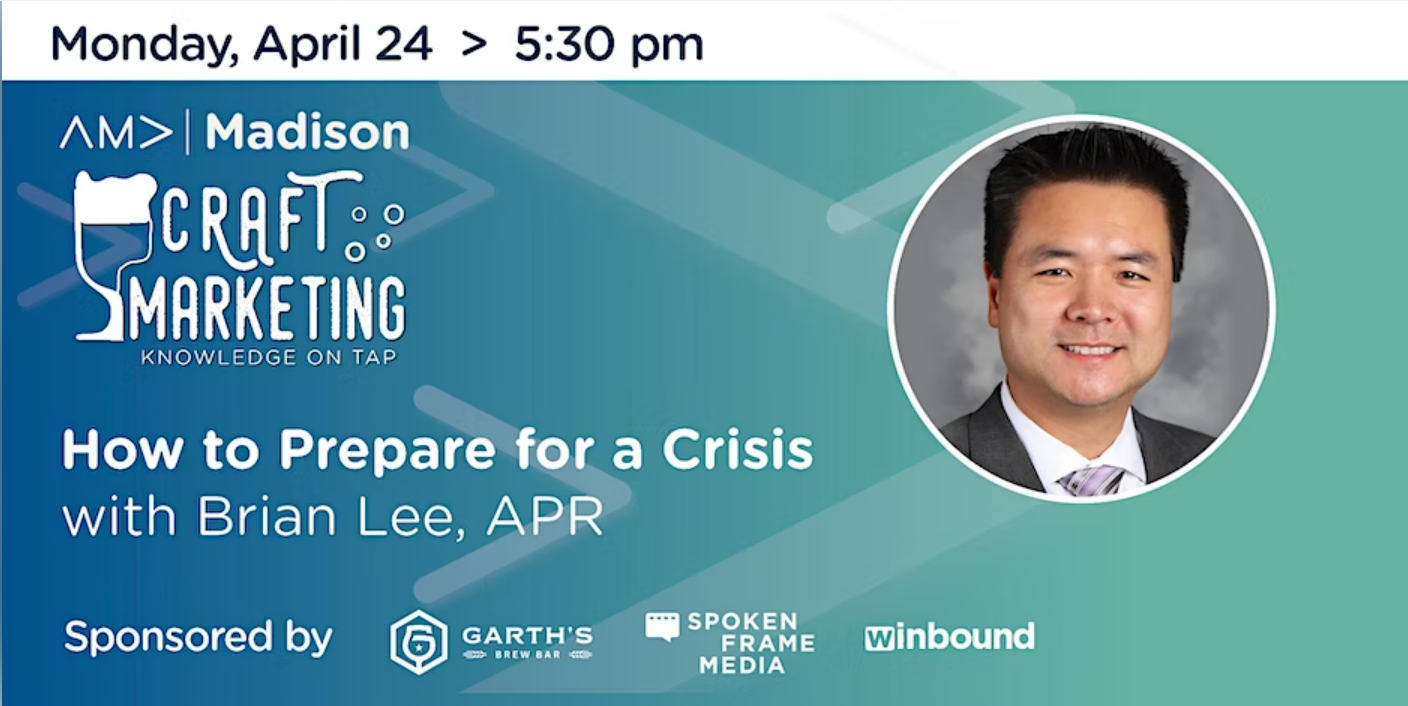No organization is immune to crisis.
From product recalls to scandals and security breaches, these disasters damage your company’s reputation, leading to revenue and brand value losses and regulatory investigations. That’s why having a crisis communications plan is so essential.
A well-crafted plan can help you rebuild trust, reestablish reputation, and restore and improve operations. But without one, you run a high risk of putting your foot in your mouth or forgetting an important reputation-saving step.
Brian Lee, APR, president of Revelation PR, Advertising & Social Media, joined AMA’s April 24th Craft Marketing event to break down the process of preparing for a crisis step by step. Read on for a recap of how to prepare for any disaster that could come your way.
The 6 Steps to Prepare for a Crisis
1. Group Together Similar Types of Crises
You never know what kind of crisis could be around the corner, so it’s best to devise a plan for virtually any scenario. Brian explained that the most effective way to cover all your bases is to list all the different crisis scenarios your company could possibly encounter. Then, group your scenarios into categories. Grouping them will save you lots of time down the road since you’ll only have to come up with a plan for each group, rather than every individual scenario.
Your category list will be unique to you, but Brian and his team came up with the following categories and example scenarios:
- Environment: i.e. a natural disaster or pandemic.
- Staff: i.e. substance abuse on the job, sexual harassment or assault.
- Violent: i.e. a bomb threat or shooting.
- Sustained: i.e. rumors of downsizing or the event of media repeating misinformation.
- Operations: i.e. a cyberattack or billing mistake.
Finally, rank the likelihood of these scenarios happening. This way, you can give the most likely scenarios the most attention.
2. Goals & Strategies
Next, come up with an overarching goal for each type of crisis. Then think of what strategies you’ll need to accomplish to achieve it. For example:
- Cybersecurity breach: Your overarching goal might be to return to full operations in 6-8 weeks, and your strategy could be to have all staff pass a cybersecurity awareness course every year. Or, you could create signs to place at every workstation reminding employees what the signs of a phishing email are.
- Pandemic: Your overarching goal could be to limit tourism losses. Strategies could include providing ample information to all audiences or creating a prewritten template for a press release, social media posts, or frequently updated blog articles. You could also come up with trigger events that are transparently shared with the public and written in your bylaws. For example, you could rule that if airports close due to a pandemic, your event will be rescheduled and registrants will receive a reimbursement or get their dues transferred to the next year’s event. You could also set the strategy of making an online event possible as a fallback.
Pro Tip: Anything That Can Be Prewritten Should Be!
Anything that can be prewritten should be. Getting approval for items like press releases can take a while, so having a template ready for copy/pasting will save you time. Additionally, don’t assume you’ll remember to do something. You never know what might slip your mind during a stressful event. Write down every strategy and step so you have a list to consult.
3. Target Audiences
Each target audience has its own set of strategies that aligns with it. Brian emphasized that your top priority needs to be your internal audience, including employees, volunteers, board members, etc. These groups must be informed before anyone else and be on the same page immediately. When you talk to them, you can demonstrate your concern and instruct them on how to respond if a customer or media member reaches out to them asking about the crisis. Telling your internal audience first also stops the rumor mill before it can start. Then, you can inform your external audience, like local officials, customers, investors, etc. Make sure your messaging is consistent between your internal and external audiences.
4. General Actions & Responses
When planning your general actions and responses, you must first acknowledge the situation head-on with empathy. Like Brian says, crisis communications isn’t just about what you say, it’s about what you do. Society can forgive you. You just have to show that you care.
Beware of common self-sabotaging mistakes like:
- Using technical jargon in your statements.
- Framing yourself as the victim or generally making the crisis about your organization.
- Coming across as whiney or arrogant.
- Leaning on logic. Too often, this makes you look insensitive and only hurts you in the public’s eyes.
- Acting in denial of the crisis.
If possible, plan to be the first to share the news of a crisis. Being the first means that you can shape the narrative and any subsequent media coverage is a response to your acknowledgement. Additionally, be as transparent as you can about what occurred, the steps you’re currently taking, and to give updates as you proceed to subsequent steps. Think of it as a live update to all your audiences as to how you’re reacting. Then, explain how you’re going to prevent this crisis from occurring ever again.
5. Policies & Procedures
As the marketing team, you need to be constantly up-to-date with your company’s policies and procedures. With this awareness, you can identify gaps that could lead to a crisis. You might even notice a policy that isn’t in writing yet that really should be.
Policies and procedures to monitor include:
- Code of conduct
- Employee onboarding and training
- Social media usage
- Sales and catering
- Drug and alcohol
- Anti-discrimination and harassment
- Security and cybersecurity
- Telecommuting.
Brian recommends reassessing these policies and your overall crisis communications plan at least once a year.
6. Train & Prepare Your Team
Marketing’s Role
Your marketing team will need to communicate with sponsors, pull all promos, advertisements, and social media posts, and purchase apology social media spaces. If even one of these steps is neglected, things can get dark fast. Think: a silly meme you scheduled to post on Twitter could appear right below your serious apology advertisement on someone’s timeline. Every step matters.
Creative’s Role:
Your creative team should create apology ads and redesign or relaunch products. They should also create a “dark” site, or a pre-built, stand-alone placeholder website that’s activated during a crisis. The dark site’s purpose is to provide a reliable, single source of information. It could even be as a simple as a flash overlay that has a link for media personnel and a link for the public.
By following these steps, your organizations will be well-prepared to communicate effectively if a crisis occurs, keeping your brand reputation protected.
See You at Garth’s Brew Bar for May’s Craft Marketing
Craft Marketing invites you to its next live in-person event at Garth’s Brew Bar in Madison at 5:00 PM on May 22nd, “Uh Oh Marketers: Now It’s Your Turn to Sell!” presented by Greg Mischio. Greg will show you how to build a marketing strategy around generating sales, create content that inspires a need for change, and more. Plus, you’ll get to network with your peers and enjoy a delicious craft beer.
Register here for the in-person event.
Thanks to our sponsors:
About the Author
Kara Martin, Content Writer at Naviant, specializes in written B2B content, from case studies to blogs and beyond. She transforms complex technical information into compelling, data-driven content that helps organizations turn their digital transformation goals into a reality.




